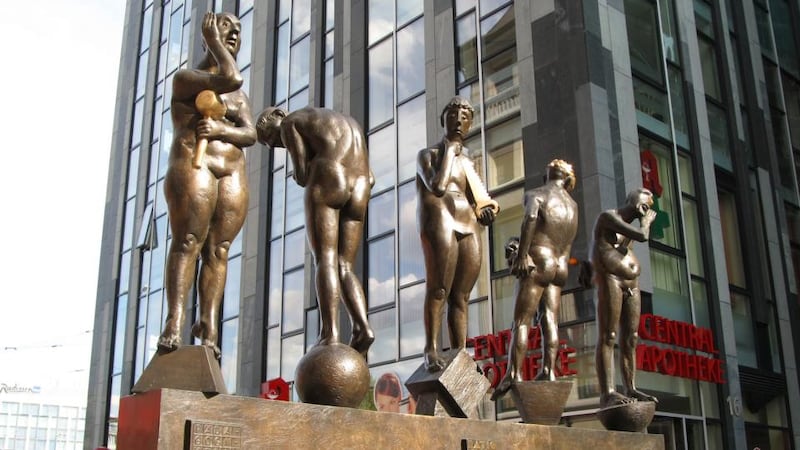I knew almost nothing about Leipzig before my first visit last May, other than the fact that it was a showpiece for the German Democratic Republic (GDR) and host to an annual trade fair during the communist period.*
Walking around the city after arriving at its vast Hauptbanhof, I found it captivating. The work of its sculptors was the most striking, and unexpected, thing. There is statuary everywhere: on streets, in niches, on doorways, on the facades of shops, churches and civic buildings. Clearly, Leipzig was in the grip of its stonemasons.
Over the centuries, they must have had a stranglehold on every significant construction project, insisting that it be embellished with sculptural elements. There couldn't be any other explanation because, no matter where you look, their work is everywhere, down to the dazzling gold-leaf flourishes on the jugendstil Commerzbank.

The most delightful piece of public sculpture, as popular as Dublin's kitsch Molly Malone, is on Grimmaische Straße, the main shopping street. Commissioned in the latter years of the GDR period, the Untimely Contemporaries (Unzeitgemäßen Zeitgenossen) features five endomorphic figurines disporting themselves naked on a bronze truss as if they couldn't care less who was looking at them.
Popular uprisings against the GDR regime started in Leipzig. Demonstrations took place in September 1989 at the Nikolaikirche and poured into Karl Marx platz (since renamed Augustusplatz). An Egyptian-style fluted column topped by bronze briars, just like the columns inside the church, marks these events.
We had tickets for the première of a new production of Wagner's Das Rheingold in the GDR-era opera house. I thought there would be something vulgar about it, like the now demolished Palast der Republik in East Berlin, but the modernist neoclassical building, which was opened in 1960, turns out to be really wonderful.
Across the broad Augustusplatz there is a vestigial reminder, in the form of a gothic-style church window, on a newly constructed faculty building for the University of Leipzig; it lights a new church that is exactly the same size as the 13th-century Paulinerkirche, which the GDR authorities dynamited in 1968.
The city’s most famous resident was undoubtedly Bach, who became cantor at the Thomaskirche in 1723. There’s a big bronze statue of him right outside the church while his tomb occupies centre stage in front of the altar, which was rescued from the Paulinerkirche.
On the southeastern outskirts is the Völkerschlachtdenkmal, a massive monument commemorating Napoleon’s defeat in 1813 at the Battle of Leipzig, fatefully foreshadowing Waterloo. With its huge scale, including the statuary, it was inaugurated to mark the centenary – rather ironically, a year before the start of the first World War.
The Old Town Hall, built in 1557, is a fine example of the German Renaissance with all the titles of the Prince-Elector of Saxony spelled out in its frieze. Goethe described Leipzig as Klein Paris (Little Paris), so beautiful were its streets and squares. Large parts of it were destroyed by Allied bombing during the second World War.
There are still little streets, or gassen, including one that's crammed with restaurants and outdoor tables, and pleasant open squares. You have to keep looking up to find the real gems such as the name and bronze profile of the airship inventor, Count Ferdinand von Zeppelin, on its jugendstil headquarters.
Leipzig is easy to get around. The city centre is walkable and the tramway network extensive. But beware of the new electric buses, which creep silently through the streets. Surely it’s not beyond German ingenuity to add a bit of noise to these otherwise environmentally friendly buses?
*This article was edited on September 18th, 2013














